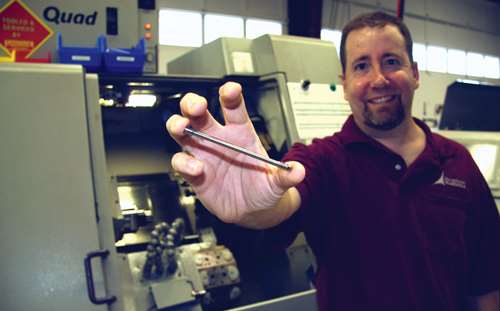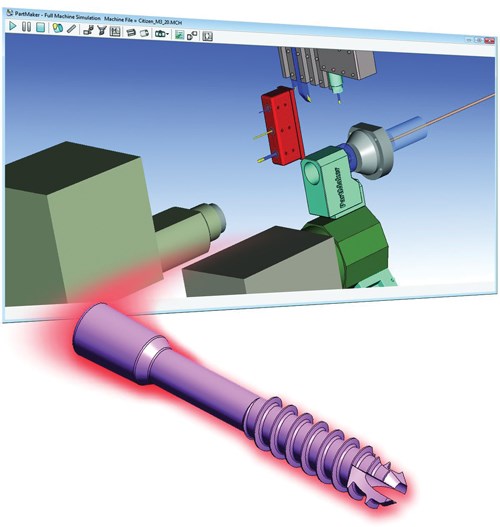Cutting Teeth in the Medical Device Business
A lot of people talk about “cutting their teeth” in a certain business as a way of referring to how they have learned a skill or trade from the ground up.For Marc Stipo, president of High Point Precision Products Inc. in Sussex, N.J., this expression has a slightly more literal meaning.
A lot of people talk about “cutting their teeth” in a certain business as a way of referring to how they have learned a skill or trade from the ground up.
For Marc Stipo, president of High Point Precision Products Inc. in Sussex, N.J., this expression has a slightly more literal meaning. In honing his company’s offerings for the medical device arena including for dental, orthopaedic implant and surgical instrumentations applications, Mr. Stipo has literally cut into cadaver teeth as well as cow bones he’s gotten from a local butcher to help his customers understand how well the parts he is making for them perform.
Featured Content
“We bring a lot of unique knowledge to the table,” Mr. Stipo says, explaining how his company helps provide its customers with unique, money saving solutions for producing their medical devices. “Recently, we were making some prototype surgical tooling. After getting the prints and making some parts, we spoke to the engineer designing the parts. I said to him ‘Why don’t we develop the cutting tool here? We can go to the butcher and get some bone to mimic the surgical process you are trying to achieve and refine the part right here in our shop.’”
It’s this combination of unique knowledge and old fashioned customer service that has helped this 15-man company grow out of Mark’s father’s basement in Northern New Jersey to a leading job shop serving the medical device market. While High Point Precision Products isn’t the biggest player in medical device manufacturing, it does seek to rely on cutting edge machine tool and CAD/CAM technology to provide unique, cost effective part manufacturing solutions.
To this point, the company employs seven multi-axis, CNC Swiss-type lathes including a variety of Citizen L, K and M series models, a Star SA and two Haas vertical machining centers. In order to be competitive and provide its customers with fast turnaround and the shortest possible lead times on complex medical devices, High Point programs all of the machines with Delcam’s PartMaker CAM software.
“In today’s medical device industry, engineers are using CAD to the fullest of its capabilities, which means part geometries are getting more complicated,” Mr. Stipo says. “As a result, there have been countless jobs we wouldn’t have been able to produce without PartMaker.”
Mills are Cars, Swiss Machines are Houses
From a machine tool perspective, High Point Precision Products’ mix of machines leans heavily toward complex Swiss-type lathes, although it has ample milling capability. The CNC mills in use at High Point range in cost from $50,000 to $60,000 where as the Swiss machines generally cost between $250,000 to $300,000 each. As such, the Swiss machines have a much higher opportunity cost of capital, so it is paramount that they be kept up and running as much as possible, no matter the lot size.
To help outsiders better understand the cost of investing in Swiss machines versus mills, Mr. Stipo draws an analogy between cars and houses.
“The price point of buying a typical milling machine between $50,000 and $60,000 with 5 to 7 years to pay it off is like buying a car. That doesn’t seem so bad,” Mr. Stipo says. “When you buy a CNC Swiss-type lathe between $250,000 and $300,000, that’s like buying a house and paying it off in 5 to 7 years. As a result, Swiss machines have to be able to produce at a high hourly rate to justify their cost.”
According to Mr. Stipo, the best way to achieve this is to make technically demanding, complex parts, which is exactly where PartMaker software helps. PartMaker helps High Point program more complex parts. The software allows the company to program faster and in a more automated fashion, which in turn, leads to fewer errors on the shop floor. Getting the programming of a part right the first time, even for the company’s complex array of Swiss machines, leads to faster setup times and shorter leadtimes for its customers.
“We don’t get paid while we’re setting up or even running our machine. We get paid when the parts are done and shipped to the customer,” Mr. Stipo explains. “Being a contract manufacturer isn’t like being a building contractor where you get paid as jobs move along to completion; you only get paid after the job has been done successfully, so we need to make sure to get jobs turned around as fast as possible.”
Bigger isn’t Always Better
Although High Point is a rather small shop, they are able to compete with much larger outfits on the basis of the skill of their staff and the sophistication of their technology. As Mr. Stipo sees it, even in very large machining organizations, there might only be three of four individuals who really have an in-depth knowledge of part processing. According to Mr. Stipo, what this leads to is a situation where knowledge becomes defuse across an organization, and these individuals become spread very thin.
Focusing the unique talents of a small group on a customer’s problems keeps High Point a step ahead. It allows Mr. Stipo and his team to come up with practical cost saving ideas, like testing on animal bones for surgical tools or cadaver teeth for dental implants.
Being smaller also enhances the need for diversification among the customer base. Having a CAM system that allows for the quick programming and turnaround of parts allows the company to satisfy a diverse customer base across a relatively small number of machines without running into capacity problems.
Complex Machines, Complex Programming
The Swiss machines in use at the shop have upwards of 11 programmable axes, a level of complexity that must all be taken into account by their CAM system. Delcam’s PartMaker manages this complexity through the application of two unique technologies for automating the programming of multi-axis Swiss type lathes. These technologies include the “Divide and Conquer” programming approach for programming parts with a number of turned and milled features. With all the advanced milling High Point is doing on its medical parts, the ability to program the various milling functionality of its Swiss machines is critical. The second technology in PartMaker that Mr. Stipo’s firm is able to take advantage of is the software Visual Synchronization approach, which allows a simultaneous machining process to be synchronized quickly and easily.
“PartMaker allows you to quickly see where you have excess spindle waiting time so we can make sure our part cycle times are optimized before sending a program to the machine,” Mr. Stipo says. “Having the ability to run ‘What If’ scenarios offline saves machine time and assures our customers the best possible price for their products.”
Prototyping for Success
High Point does business with a number of smaller, start-up medical device manufacturers. Mr. Stipo finds that such customers are receptive to the sort of experience and counsel that his company has to offer. By taking a hands-on approach with these customers, Stipo is able to reduce their product development cycle from months to weeks by moving some of the interative work involved in prototyping and product development out of the lab and onto his shop floor. All testing occurs in an area sequestered from the shop floor such that there is no possible risk of contagion with the production floor.
“We’ve actually done tests on customers’ parts on our shop floor and presented the information about which part designs perform the best,” Mr. Stipo explains.
“To design a part on a computer, then to have us make it, then to try it out in an R&D lab can be very time consuming. When you are at the machine, making these changes can just be a couple of key strokes, or a quick change in PartMaker. The reality for our customers is that they’re not making any money unless they have product out on the market. Working collaboratively with them like this can also make the machining easier and bring their costs down even further.”
RELATED CONTENT
-
From Setup to Final Pass: CNC Tool Management
With today’s high-powered and graphic-intense CNC, operators have everything under control, all on one screen.
-
Keeping Watch on Small Parts
From watch parts to exotic medical applications, this shop takes on the world of micromachining.
-
Consider the Software Side of Cutting Tools
The intersection of the cutting tool and the workpiece it is applied to represents the very heart of subtractive metalworking. There is a significant amount of technology behind getting the cutting tool into the right place, at the right speed and the correct depth of cut. This article looks at some of the software technology that can optimize the performance of the cutting tool.








